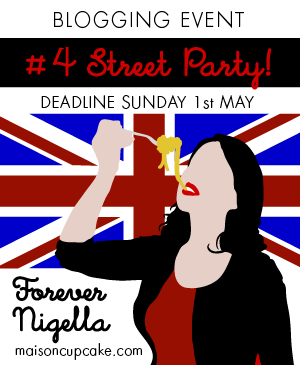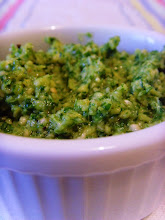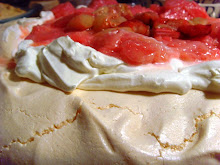The end of summer has brought with it a host of new cook books to browse and devour and I've been lucky enough to receive several new titles to drool over. I'm thrilled in my new house to have all my cook books in one place and easily accessible. I have a fairly obscene number and should, no doubt, have some kind of amnesty, but I can't bring myself to part with a single tome. Browsing through the new titles (thank you
Octopus Publishing and
Innocent) led me to consider what it is that I really like in a cook book. And the things that I don't like.
1. Pictures, pictures and more pictures. I like to see a picture of the 'finished dish'. As much as I am an imaginative sort, it is usually the pictures that seduce me and lead me from reading to cooking. My one key caveat here is Nigel Slater with his Kitchen Diaries. His writing is so evocative that I'm prepared to forgo the pics and head for the kitchen regardless. But usually, I need pictures. And this, as I mentioned, means pictures of the food. Not pictures of the cook, her glamorous home or even the ingredients. But pictures of the food being cooked. Pictures of the finished dish. I want to see onions sweating in a pan. Fluffy meringue. Wobbly jellies. Crispy-skinned duck. Steaming bowls of stew.
2. Recipes I can actually imagine cooking. For me this means recipes easily-achievable for the home cook. Things I might actually cook for supper rather than things I'd go to a fancy restaurant to eat. Much as I might enjoy foams, froths and liquid nitrogen in my local gastro-destination, I'm happy to stick with somewhat simpler techniques at home.
3. Options. I love recipes with options and ideas. When it says 'if you don't fancy chicken, why not try this with rabbit'. 'If you've forgotten to buy the cider, you can use apple juice/white wine/stock'. If you've some leftover, add some cream and make a pasta sauce/chop it up and use as a base for trifle/add potato and fry to make a rustic hash'.
4. Tips. Along with options come tips. Particularly ones about which bits to make in advance. So useful. Freezing tips also welcome. Tips for peeling butternut squash also invaluable.
What do I dislike?
1. Recipes which haven't been properly tested in a home kitchen. Celebrity chefs are the main culprits here. I find all too often that their recipes simply don't work well. I find recipes created, developed or tested by home economists or home cooks do work well.
2. Poor proof reading. Don't get me started. This is one of little 'things'. Totally excusable in a speedy blog post but in a book that has taken months to prepare? No excuse at all. I'm sorry. As I say, it is one of my 'things'!
3. Too many photos of the chef and/or his/her home/children/friends/pets/lifestyle. Just show me the food please!
4. Faddy books that are too specialist and fly-by-night. I prefer my cook books to be more of the timeless sort that I'll return to again and again over the years.
So. I must admit that it was with a touch of cynicism that I picked up Tana Ramsay's new book 'I love to bake'. The front features a combination of admittedly tempting shots of the sort of food I like to eat and slightly nauseating photos of Tana herself posing in the kitchen looking serene and domestic-goddess-like. I must confess that I've not taken much interest in Tana's other books and have perhaps dismissed them assuming that she is simply cashing in on her husband's fame.
I was very pleasantly surprised. As I flicked through the book I found recipe after recipe that I really fancied trying and plenty of food photos to inspire me (albeit interspersed with a few too many of the author herself and her photogenic family!). The book is about baking in the widest sense. Yes there are cakes, pies and breads. But Tana's baking also extends to lamb hotpot, baked tomatoes, mackerel fishcakes and a stunning-looking salmon en croute with minted pea and bean puree. Lots of great family dishes and recipes that kids can get involved in creating.
For those with a sweeter tooth (me included), there is plenty to tempt. From classic favourites (custard creams and baked apples) to more original offerings (hot apricot and pistachio souffles and mulled wine, plum and blackberry pie), there are dozens of appealing recipes. Despite her fondness for dessicated coconut (something I cannot abide) I'm taken in by Tana's relaxed, simple, wholesome style of cooking.
The day after receiving the book, I had my sister and her two boys for lunch. Perfect excuse to cook up a blackberry and almond tart. This tart combines a crisp dessert pastry shell with squidgy frangipane and autumnal blackberries. A winning combination but oddly one that I've not tried before. I must confess that for speed I used a good quality ready-made pastry but otherwise followed the recipe to the letter. It worked brilliantly - I was particularly impressed with the idea of brushing the pastry shell with beaten egg after blind baking and returning to the oven for 5 minutes to crisp up the pastry. Worked a treat! I would add that the tart is very versatile and would be great with raspberries, plums or other reasonably tart fruit.
This recipe is truly delicious and I urge you to try it. Tana's book has surprised me and I can see myself trialling quite a few of the recipes of the next few months.
Almond and Blackberry Tart
In my own words. For exact recipe, please see Tana Ramsey's 'I love to bake' published by Octopus Books.
Ingredients
350g dessert pastry (recipe can be found in the book)
175g unsalted butter
150g caster sugar
200g ground almonds
2 large free range eggs, lightly beaten
1 unwaxed lemon
1. Lightly grease an 8.5 inch loose-bottomed tart tin and line the base.
2. Roll out the pastry on a floured surface until the thickness of a £1 coin. . Line the tart tin, pushing into the corners. Prick all over with a fork and pop in the fridge to chill for at least 45 minutes.
3. Pre-heat the oven to 180C. When chilled, line with baking paper and fill with baking beans. Bake blind for 15 minutes and then take out of oven and remove the beans and baking paper. Brush the case with a little of the beaten egg and return to the oven for a further 5 minutes, until slightly golden.
4. Whilst the case if cooking away, get started on the frangipane. Pop the butter and sugar in a food processor or mixer and beat until pale and fluffy (use a paddle attachment if you have one). Mix in ground almonds and then add the beaten eggs and lemon zest, a little at a time.
5. Pour the frangipane into the tart case and then arrange the blackberries in the mixture - pushing down into the the gloop. Make a pretty pattern, if you can!
6. Bake in the oven for 35-40 minutes until the frangipane is firm to the touch and springs back slightly. Remove and cool on a wire rack for 15 minutes or so. Serve warm with vanilla ice-cream or cream.




































































